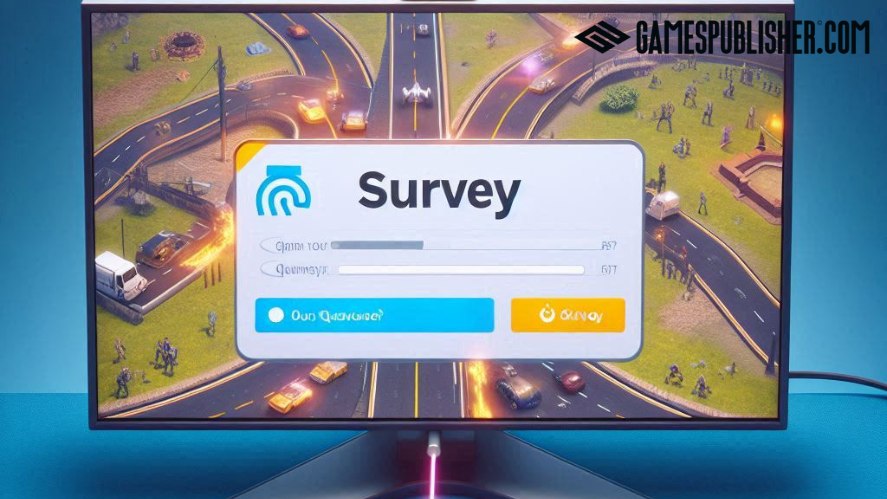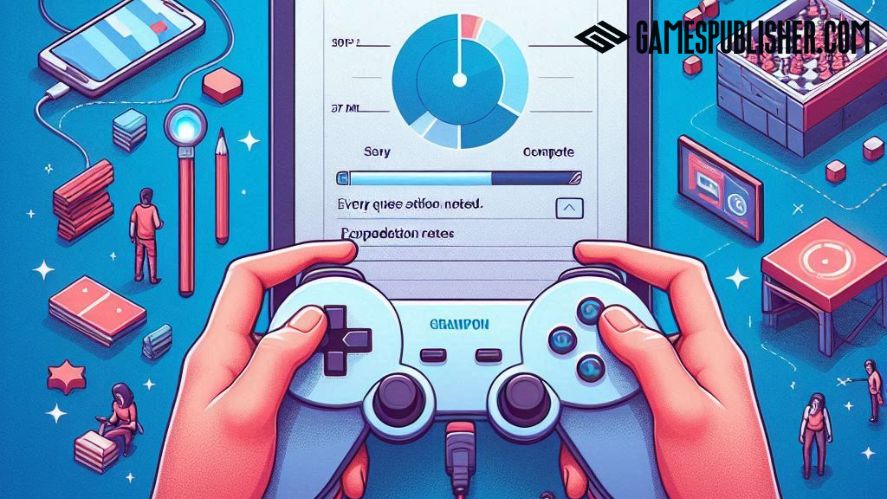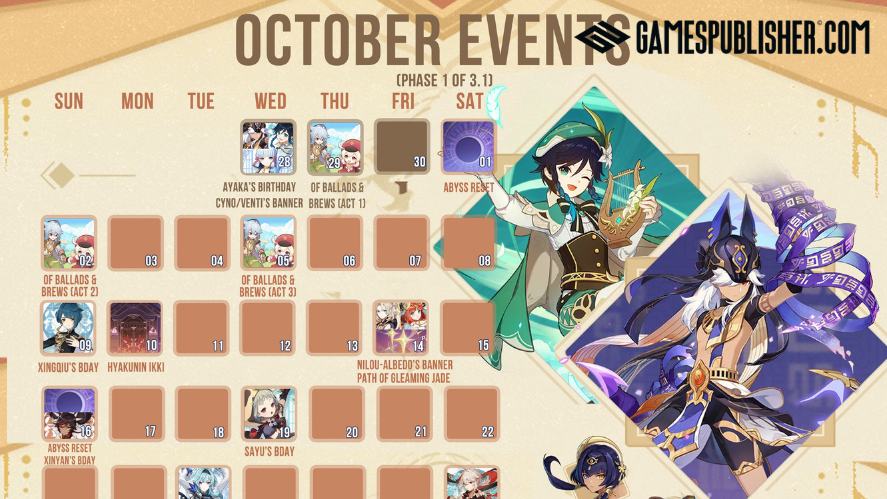The context of gaming is changing.
We all know that surveys taken after the game has been released are one of the ways game publishers can interact with the players.
These are data for understanding player behaviors, identifying pain points, and helping shape future development decisions.
Everyone knows this is necessary, but not everyone can design in-game surveys to provide better player feedback. So, let’s dive into it.
The Importance of In-Game Surveys for Game Development
Players’ feedback must be well handled to succeed in today’s game industry. So, in-game surveys are one of the best direct lines for collecting data for game development.
Such an approach fosters better game design and improves players’ functionality and experience, increasing loyalty.
In-game surveys are very effective survey since they can be administered while the players are playing games. They do not interrupt the gameplay or make players exit the game they are in.

For that, this type of survey game analysis increases response rates significantly. Moreover, this is very useful because gamer feedback genuinely reflects the player’s mood answering.
Game developers will have valuable data to know how the game is played and received.
Remember, the game success dramatically relies on players. Game feedback from gamers helps developers understand their target market and then create games that players love.
Types of In-Game Surveys
Different survey methods will have different results. That’s why you need to use a variety of survey strategies.
Let’s explore some popular types of in-game surveys!
1. Post-Level/Session Surveys
This game survey appears after a level or a gameplay session is over. They are ideal since they allow instant data on specific experiences, issues, or moments of delight.
Post-level or session surveys reveal the suitability of version updates, gameplay, and strengths to be leveraged by developers.
2. Periodic Player Feedback Surveys
These surveys are periodic and pop up at some crucial stages. For example, after an update, releasing of a new feature, or after an essential phase in the player’s game.
If used well, they provide a better vision of the player’s overall experience, measure the satisfaction and interest in upcoming content, and know what changes players want.
3. Micro-Surveys
Like the name, micro-surveys are very quick and focused on essential insights.
It takes only one or two questions, making it possible to gather feedback without interrupting the game or putting players off.
Micro-surveys are especially valuable in capturing players’ opinions on a particular aspect, maybe a feature or mechanic.
4. Reward-Based Surveys
Everyone loves rewards!
This survey gives gamers rewards within the game for completing the survey. This could be in virtual currency, experience points, aesthetic objects, or early bird access to the following content.
However, you must maintain balance because it’s easy to get carried with extrinsic rewards and forget the goal of collecting honest player feedback.
When conducted at the right time during gameplay, in-game surveys can help provide a holistic understanding of your player insights.
Also, game developers can identify features that need improvement and create a loyal community of players.
Best Practices for Designing In-Game Surveys
To create an efficient in-game survey, it’s necessary to do more than ask some questions.
Most importantly, it is about understanding your players, appreciating their time for you, and providing them value.
Keep Surveys Short and Relevant
People want to take a short survey when they play a game. Your surveys should be compact, ideally under 5 minutes to complete.

Make sure that every question asked is needed and pertinent to the experience of the player. This not only increases the completion rates but also makes sure that the collected data is meaningful.
Timing is Key
Timing is essential in deciding whether to use high game survey response rates.
You can survey anytime. However, if you don’t want to receive negative feedback, let’s choose the right moment for a game survey.
For example, after a game set, before a version update, or when loading the game. This will reduce discomfort and increase survey participation rates.
Design for Mobile and Console Usability
Not all players use the same devices. Thus, make sure your surveys can be accessible on different devices.

Let’s create friendly interfaces, especially for mobile users, and see that the texts must be large enough to read.
Prioritize accessibility to collecting gamer feedback from all segments of your player market.
Question Variety
Different question formats will have different survey results.
The questions that can be used in the survey include multiple-choice, Likert scales, and open-ended questions.
By doing this, you will be able to capture quantitative data for quick analysis and qualitative data, which will provide more details and a range of answers.
Avoid Bias
The way questions are significantly worded affects survey results. Try to avoid asking questions that would lead players to a particular answer.
Avoid loaded language, double-barreled questions, and assumptions about the player’s experience.
Incorporating Data from In-Game Surveys
Collecting user feedback is just the first step.
To truly benefit from in-game surveys, you need a systematic approach to analyzing and acting on the data you gather.
Analyzing Survey Results
Once you’ve collected your survey data, it’s time to organize and analyze it.
Start by cleaning the data and removing any incomplete or irrelevant responses. Then, segment the data by player type, playtime, demographics, or other relevant factors.
The above makes it easier for you to identify the behavior of different players to decide on action.
We suggest the user feedback tools like Polling.com for easy data visualization and analysis.
Turning Feedback into Actionable Insights
Next, translate those survey results into concrete actions. Identify the problems that need improvement, such as item prices, interface, new content, etc.
Only some of the feedback given will always be handled.
Thus, the player’s concerns and preferences need to be heard, and decisions on what changes to prioritize need to be made.
Iterative Feedback Loops
In-game surveys aren’t just a one-time thing. So, let’s establish a continuous feedback loop with your players.
Regularly conduct surveys to track player sentiment, monitor the impact of changes, and gather new ideas for future updates.
If you incorporate surveys well into your game development process, you will create a large community of loyal players for your game.
Ethical Considerations and Transparency
Ethical practices should be maintained when collecting players’ feedback, and trust should be taken for better relationships with the audience.
First, spell out how survey data will be used and keep the players’ identity secret. Therefore, it is advisable not to gather personal information whenever possible and allow the players to decline any survey.

Secondly, constantly surveying players can be annoying and distracting. Be careful with the frequency and the time of surveys.
Refrain from doing surveys during significant moments in a game. Game developers should switch between various kinds of surveys and also possible to offer rewards to encourage surveys.
By prioritizing ethical practices and transparency, you can foster a positive relationship with your players and create a feedback loop that benefits everyone.
Remember, player trust is invaluable.
Examples of Successful In-Game Surveys
Let’s examine examples of popular games applying in-game surveys to capture the player’s feedback.
Case Study 1: Fortnite’s Player Experience Surveys

Fortnite, a global phenomenon in the game industry, has become the epitome of fast and efficient surveys. After each match, the player is asked about the game experience or new updates.
Epic Games rewards in-game currency or unique skins to increase complete surveys. These both produce applicable value and help players love the game.
Case Study 2: Genshin Impact’s Event Feedback

Genshin Impact, an open-world RPG-type game, usually has limited-time events to make it more interesting.
Once the event ends, players will receive an in-game survey. The survey will have questions like event design, difficulty, or personal experience.
That practice helps the game developer, miHoYo, player satisfaction rating, discover the weaknesses, and enhance the following events for the players to maximize satisfaction level.
Case Study 3: Mobile Game Monetization Surveys
Mobile games use survey incentivization to study player’s spending patterns. With small incentives like coins, boosts are provided in exchange for survey responses about in-app purchases.
By these, the developers will understand the reasons for purchases, willingness or reluctance to pay, and overall spending behavior.
This information helps them optimize how they make money and help players have the best experience.
Future Trends in In-Game Surveys
The game industry is constantly developing, and how it interacts with players will also change. When technology advances, surveys will become more accessible and more accurate.
Let’s see future trends in in-game surveys.
AI-Powered Survey Personalization
Artificial intelligence and machine learning are expected to boost in-game surveys to the next level. Imagine the possibilities of the surveys designed according to interest, activity, and players’ behavior.
The times when players take lengthy and tedious surveys are over.
AI may collect massive amounts of data about them and create highly personalized surveys. This will lead to more excellent response rates and more meaningful feedback.
Real-Time Feedback Integration
No longer have to wait for the responses to the survey. The future will integrate real-time feedback in the game.
This allows for immediate action, such as responding during live broadcasts, changing game mechanics during the process, or even adapting the game to the player’s preferences in real time.
Expanding Beyond Games
Some of the rules for in-game surveys can be implemented in other fields.
Imagine personalized surveys in virtual reality environments, gathering feedback on interactive storytelling experiences, etc.
Conclusion
If used well, in-game surveys can be valuable assets for game developers who care about player experience.
By gathering the data from the game surveys, developers can enhance their relations with their players, resulting in better decisions.
Remember, the most critical asset in any game is your players.
Loading survey...

